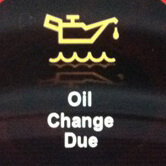How does an oil life monitor work?
Different types of oil life monitors
What determines oil life?
Oil life degrades through many factors. Here are the most important ones:
Motor Oil temperature Determines Oil Life
Studies show that oil temperature is the single most important  factor in determining motor oil life. When oil reaches engine operating temperature, it’s hot enough to evaporate water and contaminates that reduce oil life. Cold starts and short trips prevent motor oil from reaching that critical temperature.
factor in determining motor oil life. When oil reaches engine operating temperature, it’s hot enough to evaporate water and contaminates that reduce oil life. Cold starts and short trips prevent motor oil from reaching that critical temperature.
Cold starts Determine Oil Life
When you start a cold engine, the computer commands a rich fuel mixture. Since all engines have a certain amount of blow-by (air/fuel and exhaust gasses that seep past the piston rings and into the crankcase) that blow by can dilute and contaminate the motor oil. If you start a cold engine and drive it a short distance that’s not long enough to boil off the raw gas and condensation, that liquid congeals with the oil to form sludge.
Short trips Determine Oil Life
Internal combustion engines reach peak efficiency when they reach operating temperature. That’s when they use the least amount of fuel. Until that point, they run on a rich mixture, and that extra fuel and moisture winds up in the crankcase.
Stop and go driving Determine Oil Life
Acceleration puts maximum stress on motor oil. The shear caused by acceleration damages viscosity improver additives that prevent the oil from reaching its maximum viscosity. Stop and go driving dramatically shortens the life of viscosity improvers.
Dusty or extremely hot driving conditions Determine Oil Life
In addition to lubricating moving parts, motor oil’s second most important job is to remove the heat created by friction. Motor oil relies on the cooling effects of air moving past the oil pan to remove that extra heat. When you drive in extremely hot conditions, the oil can’t cool properly and it breaks down faster. Also, dusty conditions can allow dirt to enter the crankcase, causing the motor oil to become abrasive.
Turbo-charged engine Determines Oil Life
Turbos spin at close to 200,000 RPM and run extremely hot, so they require a constant flow of clean oil to reduce friction and heat. Motor oil in a turbo-charged engine will degrade faster than the same oil in a non-turbo charged engine.
Flex-fuel Determines Oil Life
E-85 fuel contains approximately 85% ethanol and 15% gasoline. The  blow-by gasses from E-85 can be more corrosive to oil in your crankcase that the same gasses from E-15 fuel. If you use E-85, you may decrease your oil life.
blow-by gasses from E-85 can be more corrosive to oil in your crankcase that the same gasses from E-15 fuel. If you use E-85, you may decrease your oil life.
Towing and heavy load operation Determines Oil Life
Towing and hauling heavy loads puts maximum shear stress on the oil molecules and viscosity improvers so they degrade faster.
High mileage Determines Oil Life
High mileage engines have more wear and that creates more blow-by and more heat due to friction. That condition results in faster oil degradation.
Oil level between changes Determines Oil Life
All internal combustion engines burn some amount of oil. If you don’t check oil level and refill between changes, you accelerate the degradation on the remaining oil.
Oil life monitor that tracks mileage
This type of oil life monitor alerts you when you’ve reached a pre-determined mileage interval since your last oil change. This is the LEAST accurate of all the types because the monitoring system has no idea how many cold starts you’ve performed since the last oil change or how you drive your vehicle. In other words, a mileage-based oil life monitoring system ignores al the oil life degradation factors listed above.
Oil life monitor that tracks your driving conditions
In this type of system, the oil life monitor tracks actual engine operating conditions. While every car maker track different factors, most look for number of cold starts and ambient air temperature, engine RPMs and hours since last oil change.
GM’s Oil Life Monitoring system (GMOLM), for example starts with a pre-determined number of engine revolutions and miles stored in memory. GMOLM starting counting down from that pre-determined number as soon as you start the engine after an oil change reset. GMOLM also tracks engine temperature and adds a multiplier to the countdown based on how far oil temperature varies from “normal.” For example, if you drive with an overheated engine above 260°, the GMOLM will immediately reduce remaining oil life to 0%. GMOLM also tracks the number of operating hours and miles, causing the oil change light to come on at 7,500 miles or one year, whichever comes first.
Ford’s Intelligent Oil Life Monitor is similar to the GMOLM, while the Fiat-Chrysler system also adjusts for the amount of ethanol in the fuel.
Oil life monitoring by oil temperature and driving conditions
VW and Audi monitor those same factors as GM, Ford and Chrysler but also look at the oil’s thermal load using a combination oil level and temperature sensor and adjusting with a fuel consumption and mileage and time algorithm. Measuring oil level land fuel consumption is important because the GM, Ford and Chrysler system DON’T track oil level. If you run those engines when low on oil, the oil life monitors will be inaccurate. So the VW and Audi systems factor in the additional wear caused when you drive with less than the recommended oil level in the crankcase.
Oil life measured by actual oil condition
All the above methods are based on empirical models and algorithms, but they don’t measure actual oil condition. To measure actual oil condition, you’d want to track the oil’s dielectric properties as it degrades, as well as the depletion of the oil’s additives. You’d also want to track the amount of fuel or coolant in the oil. Mercedes and BMW use an oil condition sensor to track those properties along with operating conditions. However, like the other methods listed, these systems assume you’ve used the recommended oil.
When you can’t trust an oil life monitor system
• You use a different grade of oil. If your vehicle requires synthetic oil and you use conventional, you can’t trust the oil life monitor.
• You use a different oil service classification. Most European engines require an ACEA class oil, while most domestics and Japanese require an American Petroleum Institute (API) SN PLUS or International Lubricants Standardization and Approval Committee (ILSAC) GF-5
• You use a different oil viscosity
• You use a long life synthetic oil with an oil filter not rated for long life
©, 2019 Rick Muscoplat
Posted on by Rick Muscoplat
